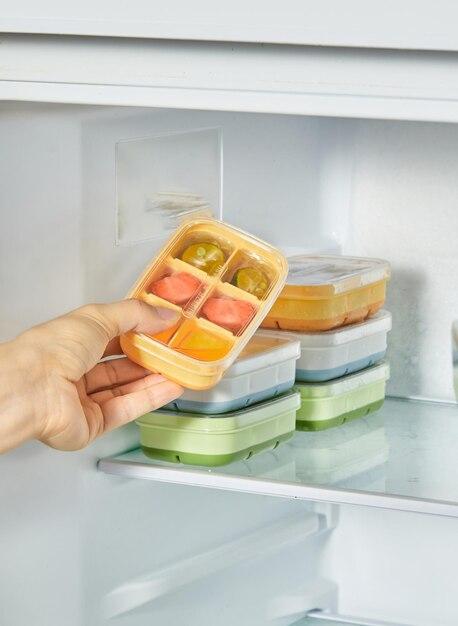Is your freezer lid no longer closing properly? Are you worried about losing energy and food due to the compromised seal? Don’t fret! In this comprehensive guide, we will show you how to DIY a new freezer lid and restore the efficiency of your freezer.
From replacing the freezer door seal to remagnetizing it, we will cover all the essential steps you need to take to ensure a tight and secure closure. We will also explore the best insulation and glue options, as well as the cost of freezer door repairs. So, whether you have a chest freezer or a walk-in freezer, this blog post has got you covered.
So, let’s roll up our sleeves and dive into the world of DIY freezer lid repair. Get ready to save money and enjoy a properly functioning freezer once again!
How to Get Creative and DIY Your Own Freezer Lid
So, your freezer lid decided to take an unexpected vacation? Well, fear not, because in this DIY adventure, we’ll show you how to tackle the task of creating a brand-new freezer lid all by yourself. No need to panic or shell out big bucks for a professional repair. With a little ingenuity, a touch of creativity, and a sprinkle of DIY magic, you’ll have that frozen fortress back in action in no time.
Gathering Your DIY Arsenal
Before you embark on this heroic mission of freezer lid DIY greatness, you’ll need to assemble your trusty tools. Here’s a quick rundown of what you’ll need:
- Measuring Tape: Get precise measurements to ensure a perfect fit.
- Plywood: This sturdy material will serve as the foundation for your new lid.
- Screws and Screwdriver: You’ll need these to secure the lid in place.
- Insulation: Keep that icy cold air from escaping by adding a layer of insulation.
- Weatherstripping: Seal the deal and prevent any unwanted drafts from entering your freezer kingdom.
Taking Measurements like a Pro
Now, before you start DIY-ing your new freezer lid, it’s crucial to take accurate measurements. Grab your trusty measuring tape and let’s get to work! Measure the width, height, and depth of your freezer opening, making sure to account for any protrusions or obstructions. Write down those measurements, and don’t worry if your handwriting looks like a doctor’s prescription – we won’t judge!
Assembling Your Freezer Lid Dream Team
With measurements in hand, it’s time to turn your DIY dreams into reality. Take that sturdy plywood you gathered earlier and cut it according to the dimensions you wrote down. Don’t forget to add a little wiggle room for the insulation and weatherstripping – it’s better to have too much material than too little!
Once you’ve cut your plywood to size, attach it to the freezer opening using screws and a trusty screwdriver. Make sure it’s snug and secure, like a well-fitted puzzle piece. A few twists here, a couple of turns there, and voila – you’ve got yourself one fine-looking freezer lid!
Insulating for Icy Perfection
Now that your freezer lid is firmly in place, it’s time to ensure it will keep that chilly air locked inside. Lay down a layer of insulation on top of the plywood, covering the entire surface. This will help maintain the freezer’s temperature and keep your popsicles nice and firm.
Weatherstripping: The Frosting on the Cake
To truly seal the deal and prevent any unwanted gusts of warmth from sneaking in, grab your weatherstripping. Apply it along the edges of your newly created freezer lid, making sure there are no gaps for heat to seep through. Think of it as the frosting on the cake – the final touch that adds that extra layer of protection.
Get Ready to Freeze in Style
Congratulations, DIY maestro! You’ve successfully crafted a new freezer lid fit for a frozen feast. Now, all that’s left to do is step back, admire your handiwork, and revel in the fact that you’ve saved the day and your precious frozen treats.
Remember, DIY projects are all about bringing out your creative side, embracing the challenges, and having a few laughs along the way. So go ahead and show that freezer lid who’s boss!
FAQ: How Do You DIY a New Freezer Lid
Is Polyurethane Spray Foam Waterproof
Polyurethane spray foam is not waterproof, but it does have some water resistance. It can provide a certain level of protection against moisture, but it is not a completely watertight solution. If you’re looking for a waterproof insulation option, you may want to consider other alternatives.
Can You Glue a Refrigerator Gasket
Yes, you can glue a refrigerator gasket. Using a strong adhesive specifically designed for rubber, you can fix a loose or damaged gasket. Just make sure to clean the surfaces thoroughly before applying the glue and allow it to fully dry before closing the refrigerator door.
What is the R-Value of Refrigerator Insulation
Refrigerator insulation typically has a low R-value, typically ranging from R-4 to R-7. The R-value measures the insulation’s ability to resist heat flow, and in this case, it helps to keep the cold air inside the refrigerator and prevent outside heat from entering.
What is the Best Insulation for a Freezer
When it comes to insulating a freezer, polyurethane foam is often considered the best option. It provides excellent insulation properties and can help maintain a consistent temperature inside the freezer. Polyurethane foam is known for its high R-value and ability to prevent heat transfer.
Can a Freezer Door Seal Be Replaced
Yes, a freezer door seal can be replaced. Over time, the door seal may wear out, become brittle, or develop gaps, leading to cold air leakage. Fortunately, it’s relatively easy to replace the seal with a new one, ensuring a tight seal and optimal energy efficiency for your freezer.
Can You Replace a Chest Freezer Door
In most cases, you cannot replace just the door on a chest freezer. The door is typically an integral part of the freezer’s structure, and replacing it would involve significant modifications or replacing the entire freezer unit. It’s best to consult the manufacturer or a professional for guidance in such situations.
How Do You Fix the Rubber on a Refrigerator Door
To fix the rubber on a refrigerator door, first, clean the rubber gasket thoroughly with warm, soapy water. Next, ensure the gasket is properly aligned and free from any obstructions. If the rubber is loose or damaged, you can apply a suitable adhesive to reattach it. Allow the adhesive to dry completely before closing the refrigerator door.
What is Polyurethane Spray Foam
Polyurethane spray foam is a versatile insulation material that expands when applied. It is commonly used for insulating walls, ceilings, and other surfaces where a tight seal is desired. The foam adheres to the applied surface, providing insulation and helping to reduce air leakage.
Is Polyurethane Foam Safe
Polyurethane foam is generally safe when installed properly. However, during the installation process, it releases volatile organic compounds (VOCs) that may cause irritation to the respiratory system. It’s recommended to follow the manufacturer’s safety guidelines and ensure proper ventilation during installation.
What is the Cost of a Freezer Door
The cost of a freezer door can vary depending on the type, size, and brand. On average, you can expect to spend anywhere from $100 to $500 for a replacement door. However, it’s always a good idea to consult with the manufacturer or a professional to get an accurate estimate for your specific freezer model.
How Much Does It Cost to Reseal a Fridge
The cost to reseal a fridge can range from $50 to $200, depending on various factors such as the size of the fridge, the extent of the seal damage, and any additional repairs required. It’s recommended to contact a professional technician to assess the situation and provide an accurate cost estimate.
Can You Reseal a Freezer Door
Yes, you can reseal a freezer door. If you notice cold air leaking from the door or any gaps in the seal, it’s a sign that the seal may need to be resealed. You can purchase a replacement seal and follow the manufacturer’s instructions to install it, ensuring a tight and energy-efficient seal.
Is Polyurethane Foam Waterproof
Polyurethane foam is not completely waterproof. While it does provide some resistance to moisture, it is not designed to be fully waterproof. If you require waterproof insulation, you may want to consider alternative materials specifically designed for that purpose.
What Kind of Glue Do You Use for Refrigerator Seal
For repairing a refrigerator seal, it’s best to use adhesive specifically formulated for rubber materials. You can look for a high-strength rubber adhesive or a specific refrigerator seal adhesive at your local hardware store or online. Make sure to read the product instructions for proper application.
How Much Does It Cost to Replace a Freezer Seal
The cost to replace a freezer seal can vary depending on the size of the freezer and the brand. On average, you can expect to spend around $30 to $100 for a replacement seal. However, it’s always a good idea to check with the manufacturer or a professional for the exact cost based on your specific freezer model.
How Do You Replace a Deep Freezer Seal
To replace a deep freezer seal, start by removing the old seal carefully. Clean the area thoroughly to ensure the new seal adheres properly. Then, using the manufacturer’s instructions, install the new seal, making sure it is aligned correctly and provides a tight seal when the door is closed.
How Do You Remagnetize a Freezer Door Seal
To remagnetize a freezer door seal, you can use a strong magnet, such as a refrigerator magnet or a magnetic strip. Start by running the magnet along the entire length of the seal multiple times in both directions. This process can help rejuvenate the magnetism in the seal and improve its sealing effectiveness.
What is the R-Value of a Walk-in Freezer
The R-value of a walk-in freezer’s insulation typically ranges from R-25 to R-50. Walk-in freezers require a much higher insulation value compared to regular refrigerators or freezers to maintain low temperatures consistently. The high R-value helps to prevent heat transfer and ensure energy efficiency.
How Do You Glue a Fridge Gasket
To glue a fridge gasket, begin by cleaning the gasket and the area where it will be attached using warm, soapy water. Dry the surfaces thoroughly. Then, apply a high-quality adhesive designed for rubber, following the manufacturer’s instructions. Press the gasket firmly against the fridge and allow the adhesive to cure completely before closing the door.
Why Do Some Refrigerator Doors and Freezer Doors Have Polystyrene Foam in Them
Polystyrene foam is commonly used as insulation material in refrigerator and freezer doors due to its excellent insulation properties and cost-effectiveness. It helps to reduce heat transfer, maintain a stable internal temperature, and improve energy efficiency by preventing cold air from escaping and warm air from entering.
Now that you have answers to these frequently asked questions, you’re well-equipped to embark on your DIY journey to fix and improve your freezer lid. Remember to always follow the manufacturer’s guidelines and consult a professional if needed. Happy DIYing!

